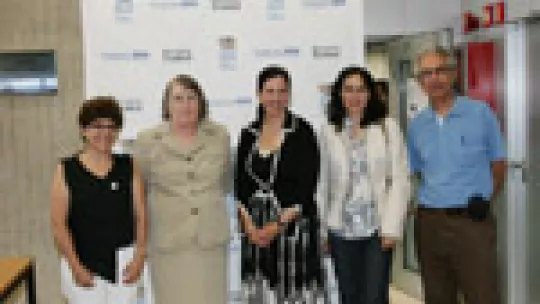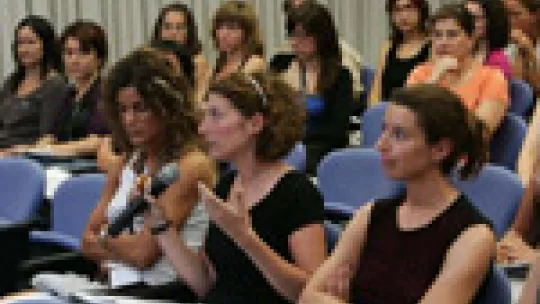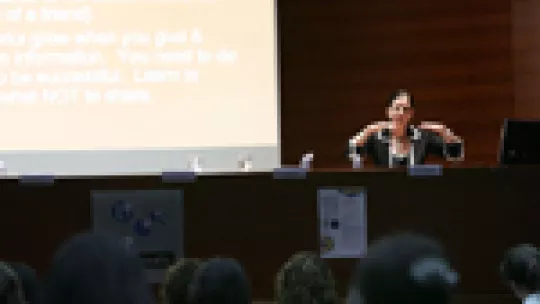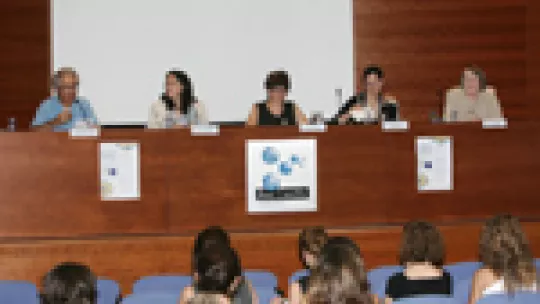Images
Four women experts offer practical advice on how to maintain leadership positions in science in a Forum organized by IRB Barcelona and the BBVA Foundation.
If the percentage of women holding PhDs in science in Spain is greater than that of men, about 53% vs. 47%, then why do so few women researchers occupy top positions, 16.90% vs. 83.10%(*)? The reason can be attributed to several factors associated with social, cultural, political and institutional aspects that do not favour the access of women to top positions or facilitate the reconciliation of family and professional life. In fact, most women who wish to advance in their scientific career often have greater difficulty in climbing the professional ladder, obtaining resources to fund their projects and occupying eminent posts in their field of research. This situation and the measures that are being undertaken and those required to reverse this tendency were the focus of a debate held today at the auditorium of the Barcelona Science Park entitled From woman to woman: Practical advice on how to get and stay in science, part of the Barcelona Biomed Forum series organized by the Institute for Research in Biomedicine (IRB Barcelona) in collaboration with the BBVA Foundation.
To make headway in this field, Mary Osborn, researcher at the Max Planck Institute for Biophysical Chemistry in Germany, a leading scientist and internationally renowned proponent of gender equality in science , considers it of utmost important that the change begins with public research organisations. This should be achieved by these organisations recognising the imbalance and facilitating access and increasing the presence of women in top posts and in committees. The study Gender and Excellence, (The Netherlands, 2006) confirms this approach: in selection committees that included no women, , only 7% of the representatives chosen for top posts were female, while in committees which did include a woman, this figure doubled, and when there were two or three women, it tripled. "Changing the way institutions and decision-making bodies think is much faster that doing it individual by individual", she concludes.
Another speaker in this forum, Catherine Didion, Executive Director of the Committee for Women in Science, Engineering and Medicine of the National Academies of the United States, stated that to be recognized as a scientist it is not enough to work well but necessary to position and promote oneself at a personal level. To achieve this, "it is necessary to establish and maintain a series of contacts, both vertical and horizontal, outside your strict field of work, to establish contacts and look for a good mentor who serves as a guide and defends your work". It is also essential to draw up a career plan to define your professional objectives and to make an appropriate choice of centre or institution in which you wish to work, assessing whether it supports issues of gender equality and professional and family reconciliation, as in some centres motherhood is considered a handicap at a professional level.
María Luisa Lois, 37 years old, an investigator at the Research Centre on Agricultural Genomics (CRAG), is an example that motherhood and science of excellence are compatible. Mother of a three-year-old, she has just received a prestigious European Research Council Starting Grant (920,000 euros over 5 years) that will allow her to set up her own laboratory to continue her research into plant molecular biology. "The most important thing is to stay active -ou can slow down your career for a time but don’t abandon it. And recognise that opportunities are always available".
It is necessary, however, to introduce support measures to facilitate the reconciliation of family and professional life. Several proposals presented by speaker Capitolina Díaz, experienced sociologist and research adviser in the Spanish Permanent Representation to the European Union, reflect this approach. For example, there is great interest in introducing the concept of the tenure clock-stop, an initiative that seeks to ensure that institutions to do not consider the maternity leave taken when evaluating a curriculum. Another measure is that researchers can temporarily be relieved of their teaching duties during this period in order to devote more of their time to research. In this regard, Joan Guinovart, director of the IRB Barcelona and chair of the sessions, has announced that IRB Barcelona plans to set up a support programme for female principal investigators. This initiative seeks to free them from administration tasks for three years, the time that young children require greatest attention, by hiring a lab manager.
The social dimension of the problem is reflected in the data presented by Catherine Didion on the perception that science is an activity undertaken by men: according to a survey done by the University of Harvard, only 1% of the participants identified science as an activity performed by women.
What to do to get and stay ahead in science
The debate closed with the speakers and participants in the Forum drawing up a set of guidelines and practical measures. This list seeks to summarise the key points to ensure that women have access to and consolidate their presence in top posts, both in academia and research centres.
1. Plan the next step in your career and prepare yourself for it. Don't waste time! learn to optimize it. Finish your degree on schedule.
2. Develop the attitude of a life-long learner and acquire new skills and knowledge as your responsibilities and interests dictate. Widen your horizons regarding professional opportunities in science. Create your own opportunities.
3. Move, gain experience abroad and work with other scientists. Don?t stay glued to one spot.
4. Find a good mentor (or more than one) to guide and advise you and to promote your professional career. Do the same for others.
5. Forge a solid network of contacts and nurture them. Join societies and associations.
6. Put yourself in the running. Consistently apply for grants and project funds, locally and internationally.
7. Trust yourself and take risks. Develop core strength and learn to say "no".
8. Develop your professional image and promote it. You may be a genius inside your own lab but that won't help you much if nobody knows about it. Learn how to transmit your message effectively and be aware of who your audience is.
9. Be honest about your personal and professional goals. Know what you value. Periodically weigh these factors and make your decisions deliberately.
10. Make a good choice of the institute in which you wish to work, and find a partner who accepts and supports your career and ambitions. If one or both don't work out, change them.
Summarized into two:
1. Define your professional strategy and fight for it, creating solid networks and taking advantage of opportunities. Never give up!
2. Increase your chances for success by preparing and promoting yourself.
About IRB Barcelona
The Institute for Research in Biomedicine (IRB Barcelona) pursues a society free of disease. To this end, it conducts multidisciplinary research of excellence to cure cancer and other diseases linked to ageing. It establishes technology transfer agreements with the pharmaceutical industry and major hospitals to bring research results closer to society, and organises a range of science outreach activities to engage the public in an open dialogue. IRB Barcelona is an international centre that hosts 400 researchers and more than 30 nationalities. Recognised as a Severo Ochoa Centre of Excellence since 2011, IRB Barcelona is a CERCA centre and member of the Barcelona Institute of Science and Technology (BIST).











